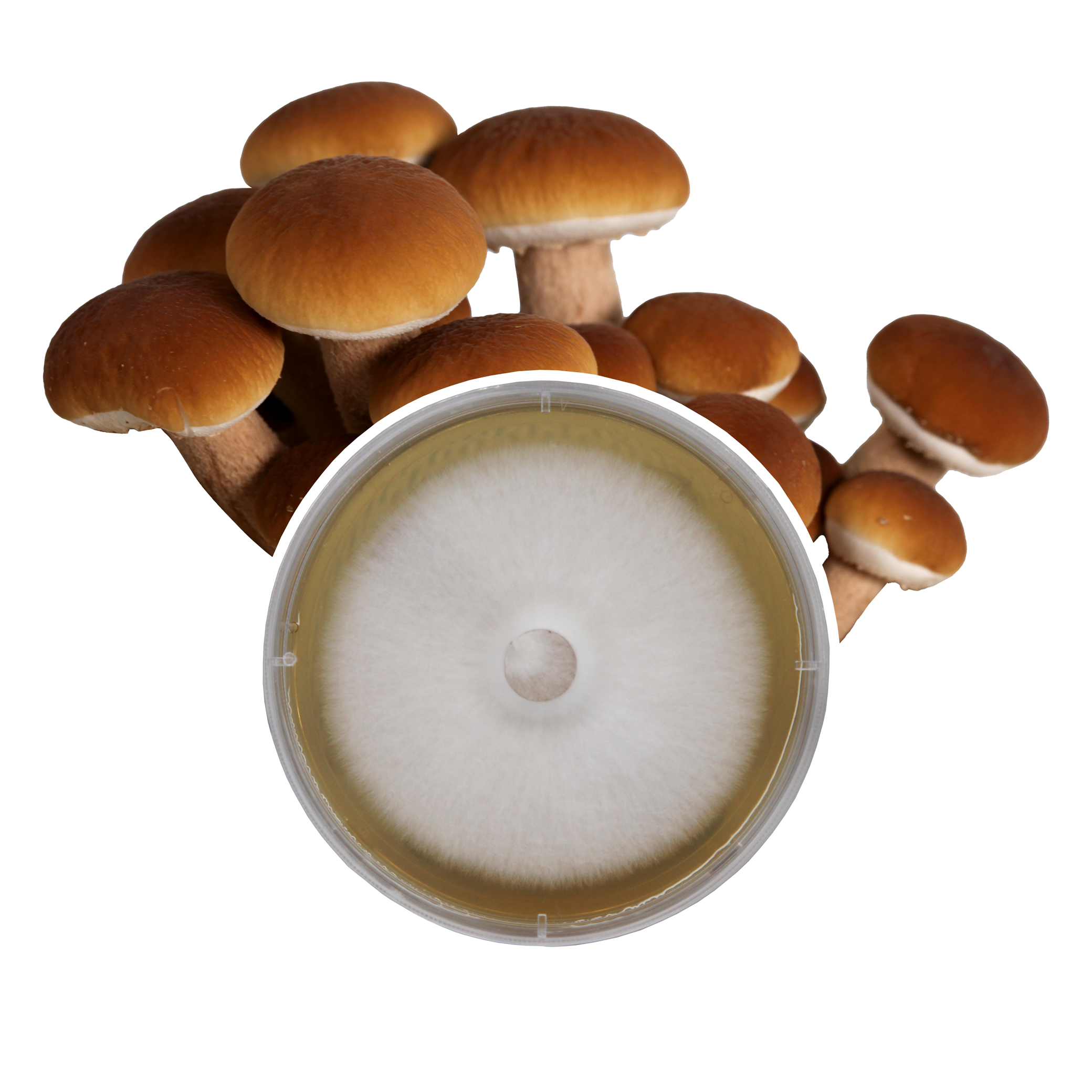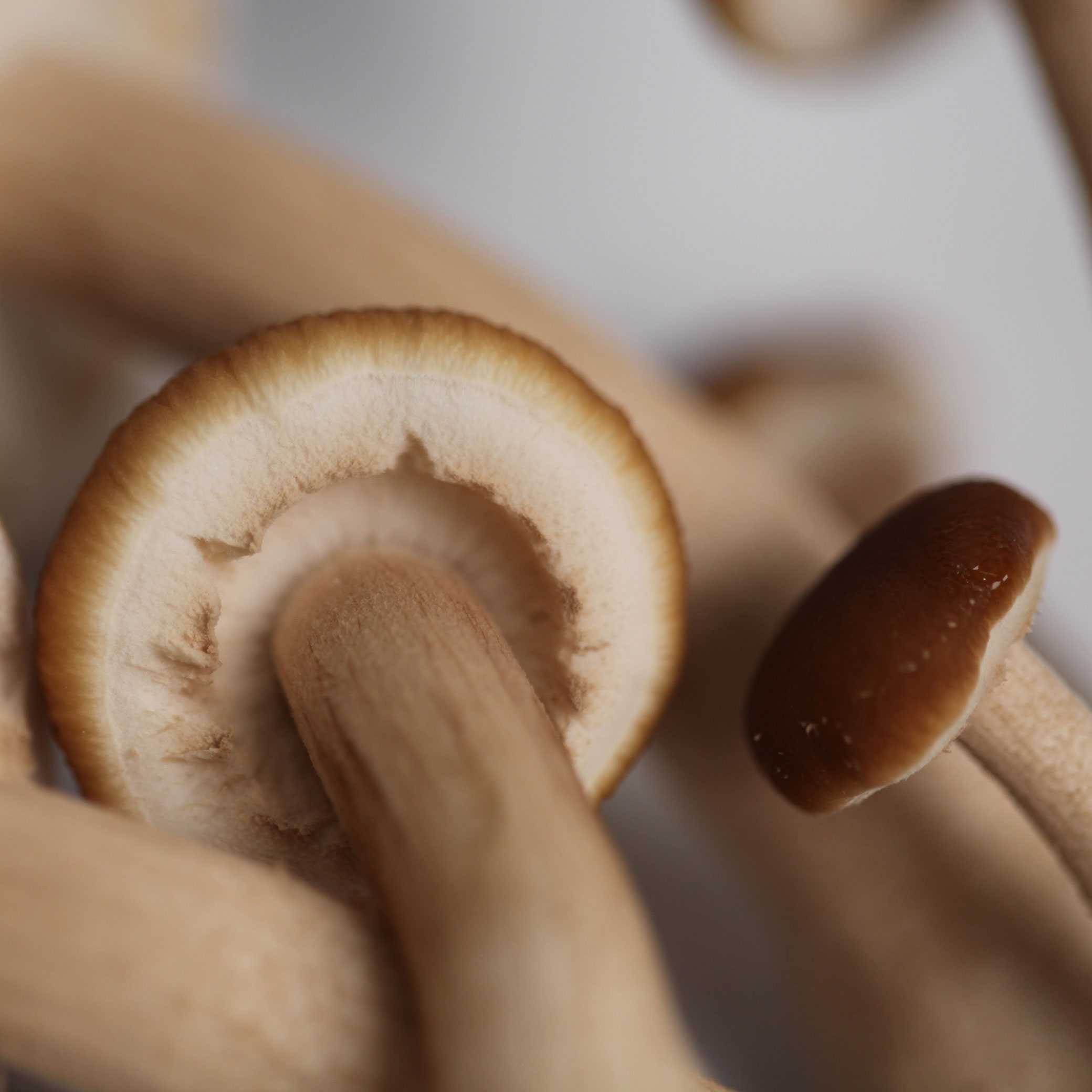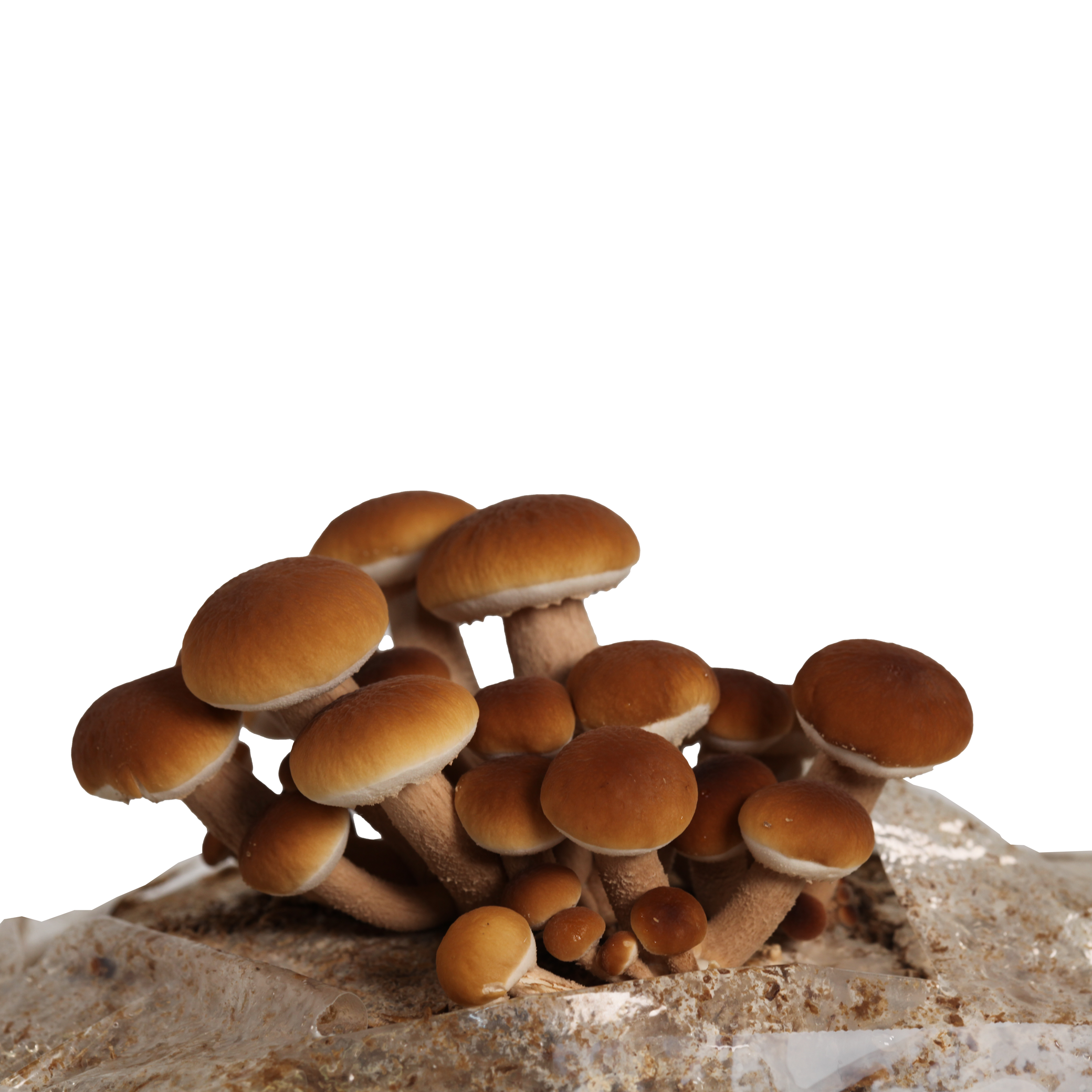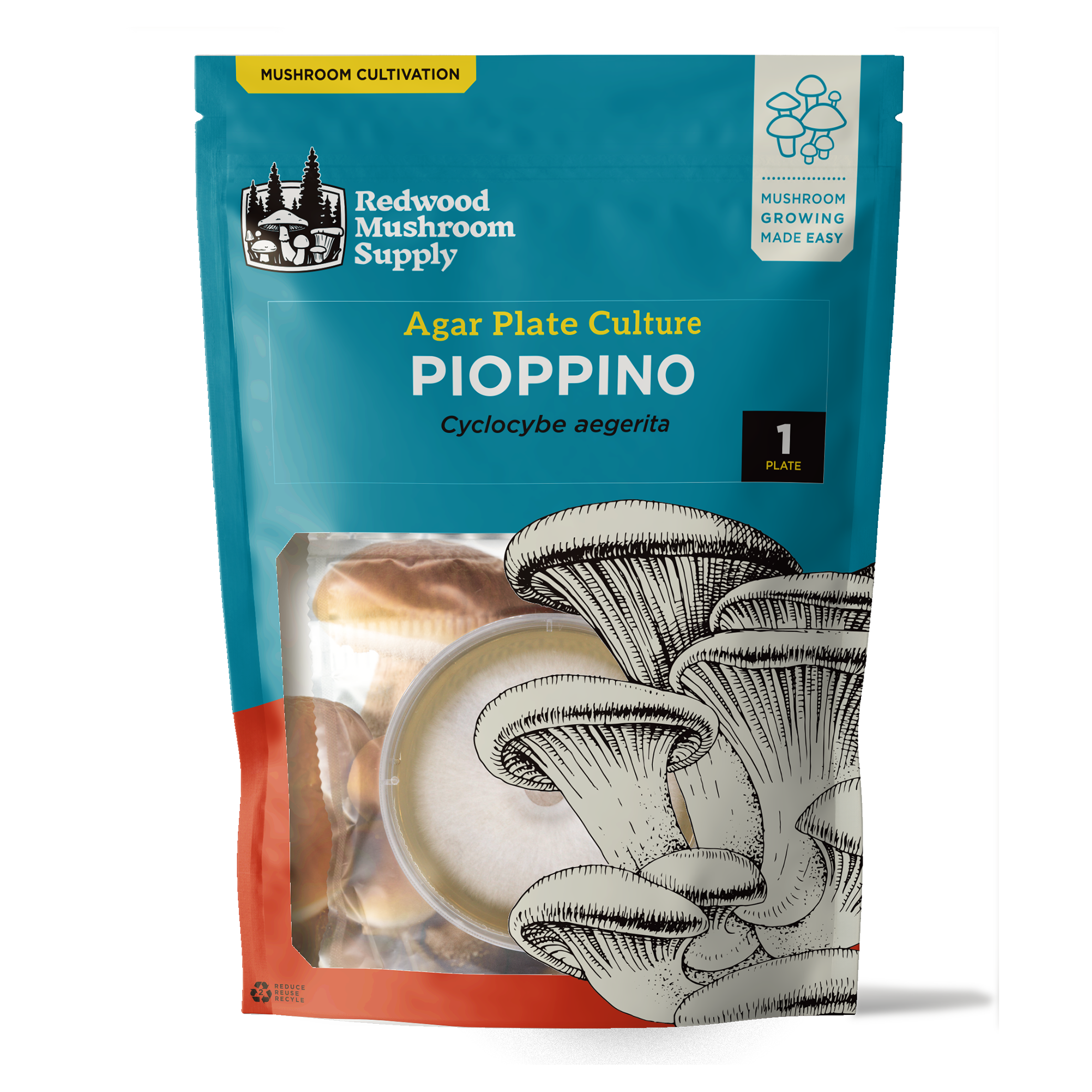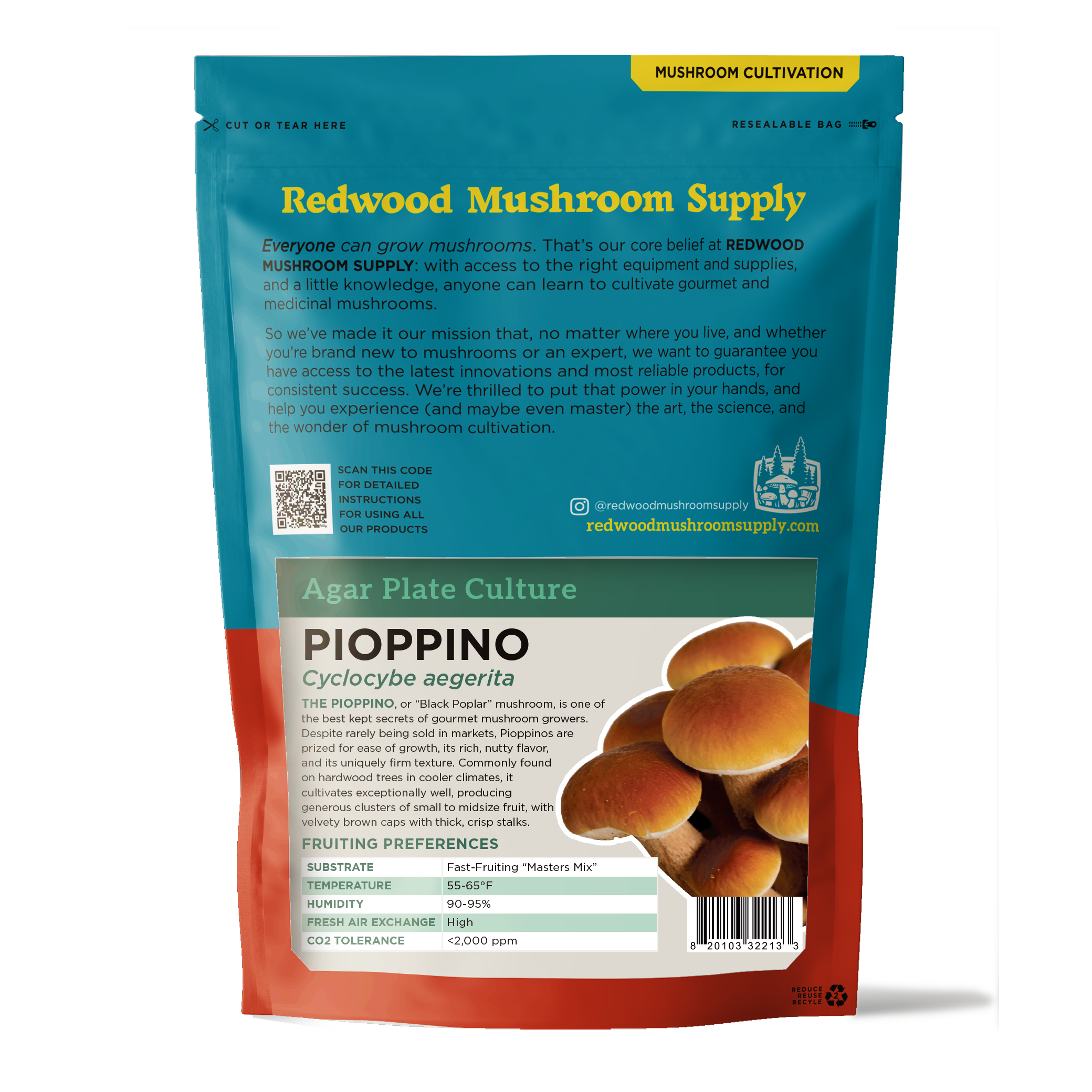Features
Pioppino (Cyclocybe aegerita)
- Pioppino plate culture
- 100 mm x 15 mm petri dish with malt extract agar
- Produces tight clusters with numerous fruit bodies
- Velvety golden brown caps
- Rich flavor and crisp texture when cooked - a staff favorite!
- Unique, visually appealing mushrooms uncommonly found in stores
- Longer shelf life than other gourmet mushrooms
- Prefers Fast-Fruiting/Master’s Mix or other hardwood substrates
Redwood Mushroom Supply Process
- Early generation cultures ensure vitality
- Plates made with high-quality, lab-grade inputs
- Sterilization verified using chemical sterilization indicators
- Each batch tracked and quality-controlled for contamination-free cultures
- Packaged in a clean-air environment
- Plates are individually wrapped and sealed in breathable filter bags
- All strains grown in-house to ensure consistent quality
Pioppino Mushroom Plate Culture
Your Price:
Pioppino mushrooms are highly valued by gourmet mushroom growers for their rich, nutty flavor and firm, crunchy texture. Enjoy cultivating your own Pioppino mushrooms with this plate culture prepared in the Redwood Mushroom Supply lab. This vigorous species thrives on fast-fruiting hardwood substrates and produces clusters of dense fruit bodies. Pioppino is one of the few gourmet mushrooms that will do well in a monotub setup. Suitable for all skill levels, using a plate culture requires a still-air box or laminar flow hood for best results.
Pioppino (Cyclocybe aegerita)
The Pioppino Mushroom is a lesser-known delight among gourmet mushroom growers. Despite being rarely available in markets, the Pioppino is prized for its ease of growth, rich nutty flavor, and uniquely firm texture. Commonly found on hardwood trees in cooler climates, it cultivates exceptionally well. This species produces generous clusters of small to midsize fruit with velvety brown caps and crisp stems.
This Pioppino strain has frequently impressed and is one of the fastest to go at RMS – it’s truly a company favorite. We recommend top-fruiting this strain from a bag. Expect a full canopy of delicious velvety caps when growing this strain!
The Pioppino mushroom is versatile in the kitchen, adding a rich, nutty flavor and a firm, crunchy texture to a variety of dishes. It pairs well with meats, vegetables, and grains, making it a favorite among chefs and home cooks alike. Additionally, the longer shelf life of Pioppino mushrooms makes them a practical choice for both fresh consumption and storage.
About Redwood Mushroom Supply (RMS) Culture
All RMS Plate Cultures are prepared from early-generation slants from their culture bank. These robust cultures are used to inoculate agar plates prepared with high-quality inputs, ensuring you receive vigorous and reliable cultures.
Each culture is hand-packaged in a clean-air laboratory environment. Their cultures are batch-tracked and undergo thorough quality control to ensure robust growth and contamination-free conditions.
NOTE: The growing instructions and predicted yields in the details and technical specifications are based on our observations and may vary based on your growing method and environment.
Technical Specifications
| Length Inches | |
|---|---|
| Width Inches | |
| Height Inches | |
| Product Weight | |
| Case Quantity | |
| Case Dimensions (L"xW"xH") | |
| Case Weight lbs |
| Materials | ||
|---|---|---|
| Thickness | ||
| Tensil Strength | ||
| Climate Suitability | ||
| Transmission Rate | ||
| Diffusion Rate | ||
| Custom Size Option | ||
| Substrate |
Hardwood, Fast-Fruiting/Master’s Mix |
|
| Temperature |
55-65°F |
|
| Humidity |
90-95% |
|
| Fresh Air Exchange |
High |
|
| CO2 Tolerance |
<2,000 ppm |
|
| Fruiting Method |
Bags in growth chamber, monotub |
|
| Bag Weight | ||
| Best Use | ||
| Category | Live Cultures |
These plate cultures provide a robust starting point for mushroom cultivation. For optimal results, we recommend transferring agar from the colonized petri dish to sterilized grain bags or jars. Once fully colonized, the grain spawn can be used to inoculate wood-based substrate at a 5-10% grain-to-substrate ratio. Perform transfers using a still-air box or laminar flow hood to increase the success of your culture expansion.
Plate cultures can also be used to create liquid cultures for bulk inoculation and can be made into additional plates or slants for storage and future use.
Storage
For best results, store your plate culture in the refrigerator until ready to use. Ensure the plate is fully sealed before storing. If you plan to use the culture within 1-3 weeks, refrigeration is not necessary. When refrigerated, plate cultures can remain viable for up to 6 months. Do not freeze, as this can damage the mycelium. Keep out of direct sunlight and avoid exposure to heat.
Plate Culture Use Instructions
EQUIPMENT CHECKLIST
- RMS Plate Culture
- Sterilized grain
- Disposable gloves
- 70% isopropyl alcohol in a spray bottle
- Scalpel
- Tool sterilizer or open flame for sterilizing tools
- Sealing film
- Recommended: Laminar flow hood or still-air box
INSTRUCTIONS
1. PREPARE YOUR ENVIRONMENT
- Wash your hands and put on a pair of disposable gloves.
- Disinfect your workspace and gloves with 70% isopropyl alcohol.
- For best results, use a laminar flow hood or a still-air box when working with open cultures.
- Note: Maintaining a clean environment is essential for successful inoculation and optimal culture growth.
2. DISINFECT MATERIALS
- Remove plate culture from the filter bag.
- Spray the exterior of the sealed plate culture and items to be inoculated with 70% isopropyl alcohol.
- Allow alcohol to evaporate completely before inoculating.
- Note: Always use sterile tools when working with cultures. Use a tool sterilizer to sterilize tools between transfers. If using an open flame to sterilize your tools, exercise extreme caution while using isopropyl alcohol in the same area.
3. INOCULATE
- Remove the sealing film and petri dish lid from plate culture.
- Using sterile tools, carefully cut a 1 cm × 1 cm wedge of agar from the plate culture and transfer it to sterile grain, agar, or liquid culture. Replace petri dish lid when complete and seal your inoculated bag, plate or jar.
- Now is a great chance to transfer your culture to additional sterile agar plates to create backup cultures.
4. COLONIZE
- Place the inoculated bag, plate, or jar in a 70-75° F environment to encourage mycelial growth.
Details
Pioppino (Cyclocybe aegerita)
The Pioppino Mushroom is a lesser-known delight among gourmet mushroom growers. Despite being rarely available in markets, the Pioppino is prized for its ease of growth, rich nutty flavor, and uniquely firm texture. Commonly found on hardwood trees in cooler climates, it cultivates exceptionally well. This species produces generous clusters of small to midsize fruit with velvety brown caps and crisp stems.
This Pioppino strain has frequently impressed and is one of the fastest to go at RMS – it’s truly a company favorite. We recommend top-fruiting this strain from a bag. Expect a full canopy of delicious velvety caps when growing this strain!
The Pioppino mushroom is versatile in the kitchen, adding a rich, nutty flavor and a firm, crunchy texture to a variety of dishes. It pairs well with meats, vegetables, and grains, making it a favorite among chefs and home cooks alike. Additionally, the longer shelf life of Pioppino mushrooms makes them a practical choice for both fresh consumption and storage.
About Redwood Mushroom Supply (RMS) Culture
All RMS Plate Cultures are prepared from early-generation slants from their culture bank. These robust cultures are used to inoculate agar plates prepared with high-quality inputs, ensuring you receive vigorous and reliable cultures.
Each culture is hand-packaged in a clean-air laboratory environment. Their cultures are batch-tracked and undergo thorough quality control to ensure robust growth and contamination-free conditions.
NOTE: The growing instructions and predicted yields in the details and technical specifications are based on our observations and may vary based on your growing method and environment.
Usage
These plate cultures provide a robust starting point for mushroom cultivation. For optimal results, we recommend transferring agar from the colonized petri dish to sterilized grain bags or jars. Once fully colonized, the grain spawn can be used to inoculate wood-based substrate at a 5-10% grain-to-substrate ratio. Perform transfers using a still-air box or laminar flow hood to increase the success of your culture expansion.
Plate cultures can also be used to create liquid cultures for bulk inoculation and can be made into additional plates or slants for storage and future use.
Storage
For best results, store your plate culture in the refrigerator until ready to use. Ensure the plate is fully sealed before storing. If you plan to use the culture within 1-3 weeks, refrigeration is not necessary. When refrigerated, plate cultures can remain viable for up to 6 months. Do not freeze, as this can damage the mycelium. Keep out of direct sunlight and avoid exposure to heat.
Plate Culture Use Instructions
EQUIPMENT CHECKLIST
- RMS Plate Culture
- Sterilized grain
- Disposable gloves
- 70% isopropyl alcohol in a spray bottle
- Scalpel
- Tool sterilizer or open flame for sterilizing tools
- Sealing film
- Recommended: Laminar flow hood or still-air box
INSTRUCTIONS
1. PREPARE YOUR ENVIRONMENT
- Wash your hands and put on a pair of disposable gloves.
- Disinfect your workspace and gloves with 70% isopropyl alcohol.
- For best results, use a laminar flow hood or a still-air box when working with open cultures.
- Note: Maintaining a clean environment is essential for successful inoculation and optimal culture growth.
2. DISINFECT MATERIALS
- Remove plate culture from the filter bag.
- Spray the exterior of the sealed plate culture and items to be inoculated with 70% isopropyl alcohol.
- Allow alcohol to evaporate completely before inoculating.
- Note: Always use sterile tools when working with cultures. Use a tool sterilizer to sterilize tools between transfers. If using an open flame to sterilize your tools, exercise extreme caution while using isopropyl alcohol in the same area.
3. INOCULATE
- Remove the sealing film and petri dish lid from plate culture.
- Using sterile tools, carefully cut a 1 cm × 1 cm wedge of agar from the plate culture and transfer it to sterile grain, agar, or liquid culture. Replace petri dish lid when complete and seal your inoculated bag, plate or jar.
- Now is a great chance to transfer your culture to additional sterile agar plates to create backup cultures.
4. COLONIZE
- Place the inoculated bag, plate, or jar in a 70-75° F environment to encourage mycelial growth.
